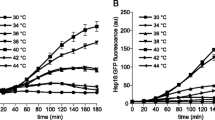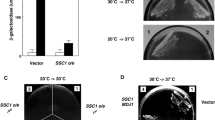Abstract
Heat shock protein Hsp104 of Saccharomyces cerevisiae functions as a protector of cells against heat stress. When yeast are grown in media containing nonfermentable carbon sources, the constitutive level of this protein increases, which suggests an association between the expression of Hsp104 and yeast energy metabolism. In this work, it is shown that distortions in the function of mitochondria appearing as a result of mutation petite or after exposure of cells to the mitochondrial inhibitor sodium azide reduce the induction of Hsp104 synthesis during heat shock. Since the addition of sodium azide suppressed the formation of induced thermotolerance in the parent type and in mutant hsp104,the expression of gene HSP104 and other stress genes during heat shock is apparently regulated by mitochondria.
Similar content being viewed by others
REFERENCES
Boy-Marcotte, E., Lagniel, G., Perrot, M., et al., The Heat Shock Response in Yeast: Differential Regulations and Contributions of the Msn2p/Msn4p and Hsf1p Regulons, Mol. Microbiol., 1999, vol. 33,no. 2, pp. 274-283.
Sanchez, Y. and Lindquist, S., HSP104 Required for Induced Thermotolerance, Science, 1990, vol. 248,no. 4959, pp. 1112-1115.
Ferreira, P.C., Ness, F., Edwards, S.R., et al., The Elimination of the Yeast [PSI+] Prion by Guanidine Hydrochloride Is the Result of Hsp104 Inactivation, Mol. Microbiol., 2001, vol. 40,no. 6, pp. 1357-1369.
Jung, G. and Masison, D.C., Guanidine Hydrochloride Inhibits Hsp104 Activity in Vivo: A Possible Explanation for Its Effect in Curing Yeast Prions, Curr. Microbiol., 2001, vol. 43,no. 1, pp. 7-10.
Newnam, G.P., Wegrzyn, R.D., Lindquist, S.L., and Chernoff, Y.O., Antagonistic Interactions between Yeast Chaperones Hsp104 and Hsp70 in Prion Curing, Mol. Cell. Biol., 1999, vol. 19,no. 2, pp. 1325-1333.
Chernoff, Y.O., Lindquist, S.L., Ono, B., et al., Role of the Chaperone Protein Hsp104 in Propagation of the Yeast Prion-like Factor [psi +], Science, 1995, vol. 268,no. 5212, pp. 880-884.
Wegrzyn, R.D., Bapat, K., Newnam, G.P., et al., Mechanism of Prion Loss after Hsp104 Inactivation in Yeast, Mol. Cell. Biol., 2001, vol. 21,no. 14, pp. 4656-4669.
De Deken, R.H., The Crabtree Effect: A Regulatory System in Yeast, J. Gen. Microbiol., 1966, vol. 44,no. 2, pp. 149-156.
Sanchez, Y., Taulien, J., Borkovich, K.A., and Lindquist, S., Hsp104 Is Required for Tolerance to Many Forms of Stress, EMBO J., 1992, vol. 11,no. 6, pp. 2357-2364.
Slonimski, P.P., Perrodin, G., and Croft, J.H., Ethidium Bromide-Induced Mutation of Yeast Mitochondria: Complete Transformation of Cells into Respiratory Deficient Non-Chromosomal “Petites,” Biochem. Biophys. Res. Commun., 1968, vol. 30,no. 3, pp. 232-239.
Lowry, O.H., Rosebrough, N.J., Farr, A.L., and Randall, R.J., Protein Measurement with the Folin Phenol Reagent, J. Biol. Chem., 1951, vol. 193,no. 1, pp. 265-275.
Timmons, T.M. and Dunbar, B.S., Protein Blotting and Immunodetection, Methods Enzymol., 1990, vol. 182, pp. 679-688.
Gauze, G.F. and Kuzovkova, L.I., Themperature Sensitivity of Respiration-Deficient Mutants of Yeast, Izv. Akad. Nauk SSSR, Ser. Biol., 1970, vol. 26,no. 2, pp. 305-308.
Traven, A., Wong, J.M., Xu, D., et al., Interorganellar Communication: Altered Nuclear Gene Expression Profiles in a Yeast Mitochondrial DNA Mutant, J. Biol. Chem., 2001, vol. 276,no. 6, pp. 4020-4027.
Rikhvanov, E.G., Varakina, N.N., Rusaleva, T.M., et al., Respiratory Changes in Yeast Saccharomyces cerevisiae Exposed to Heat Shock, Mikrobiologiya, 2001, vol. 70,no. 4, pp. 531-535.
Weitzel, G., Pilatus, U., and Rensing, L., The Cytoplasmic pH, ATP Content and Total Protein Synthesis Rate during Heat Shock Protein-Inducing Treatments in Yeast, Exp. Cell Res., 1987, vol. 170,no. 1, pp. 64-79.
Wilson, D.F. and Chance, B., Azide Inhibition of Mitochondrial Electron Transport: I. The Aerobic Steady State of Succinate Oxidation, Biochim. Biophys. Acta, 1967, vol. 131,no. 3, pp. 421-430.
Rikhvanov, E.G., Varakina, N.N., Rusaleva, T.M., et al., The Effect of Sodium Azide on Heat Shock Resistance of Yeasts Saccharomyces cerevisiae and Debaryomyces vanriji, Mikrobiologiya, 2001, vol. 70,no. 3, pp. 300-304.
Rikhvanov, E.G., Varakina, N.N., Rusaleva, T.M., et al., Sodium Azide Reduces the Thermotolerance of Respiratively Grown Yeasts, Curr. Microbiol., 2002, vol. 45,no. 6, pp. 394-399.
Ashburner, M. and Bonner, J.J., The Induction of Gene Activity in Drosophila by Heat Shock, Cell (Cambridge, Mass.), 1979, vol. 17,no. 2, pp. 241-254.
Sanchez, Y., Parsell, D.A., Taulien, J., et al., Genetic Evidence for a Functional Relationship between Hsp104 and Hsp70, J. Bacteriol., 1993, vol. 175,no. 20, pp. 6484-6491.
Wieser, R., Adam, G., Wagner, A., et al., Heat Shock Factor-Independent Heat Control of Transcription of the CTT1 Gene Encoding the Cytosolic Catalase T of Saccharomyces cerevisiae, J. Biol. Chem., 1991, vol. 266,no. 19, pp. 12 406-12 411.
Sugiyama, K., Izawa, S., and Inoue, Y., The Yap1p-Dependent Induction of Glutathione Synthesis in Heat Shock Response of Saccharomyces cerevisiae, J. Biol. Chem., 2000, vol. 275,no. 20, pp. 15 535-15 540.
Weber, J. and Senior, A.E., Effects of the Inhibitors Azide, Dicyclohexylcarbodiimide, and Aurovertin on Nucleotide Binding to the Three F1-ATPase Catalytic Sites Measured Using Specific Tryptophan Probes, J. Biol. Chem., 1998, vol. 273,no. 50, pp. 33 210-33 215.
Parsell, D.A., Kowal, A.S., Singer, M.A., and Lindquist, S., Protein Disaggregation Mediated by Heat-Shock Protein Hsp104, Nature, 1994, vol. 372,no. 6505, pp. 475-478.
Sugiyama, K., Kawamura, A., Izawa, S., and Inoue, Y., Role of Glutathione in Heat Shock-Induced Cell Death of Saccharomyces cerevisiae, Biochem. J., 2000, vol. 352, part 1, pp. 71-78.
Estruch, F., Stress-Controlled Transcription Factors, Stress-Induced Genes and Stress Tolerance in Budding Yeast, FEMS Microbiol. Rev., 2000, vol. 24,no. 4, pp. 469-486.
Lindquist, S. and Kim, G., Heat-Shock Protein 104 Expression Is Sufficient for Thermotolerance in Yeast, Proc. Natl. Acad. Sci. USA, 1996, vol. 93,no. 11, pp. 5301-5306.
Thevelein, J.M. and de Winde, J.H., Novel Sensing Mechanisms and Targets for the cAMP-Protein Kinase A Pathway in the Yeast Saccharomyces cerevisiae, Mol. Microbiol., 1999, vol. 33,no. 5, pp. 904-918.
Bussereau, F., Dupont, C.H., Boy-Marcotte, E., et al., The CCS1 Gene from Saccharomyces cerevisiae Which Is Involved in Mitochondrial Functions Is Identified as IRA2, an Attenuator of RAS1 and RAS2 Gene Products, Curr. Genet., 1992, vol. 21,nos. 4–5, pp. 325-329.
Thevelein, J.M., Beullens, M., Honshoven, F., et al., Regulation of the cAMP Level in the Yeast Saccharomyces cerevisiae: Intracellular pH and the Effect of Membrane-Depolarizing Compounds, J. Gen. Microbiol., 1987, vol. 133, part 8, pp. 2191-2196.
Author information
Authors and Affiliations
Rights and permissions
About this article
Cite this article
Rikhvanov, E.G., Rachenko, E.I., Varakina, N.N. et al. The Induction of Saccharomyces cerevisiae Hsp104 Synthesis by Heat Shock Is Controlled by Mitochondria. Russian Journal of Genetics 40, 341–347 (2004). https://doi.org/10.1023/B:RUGE.0000024969.45581.ad
Issue Date:
DOI: https://doi.org/10.1023/B:RUGE.0000024969.45581.ad




